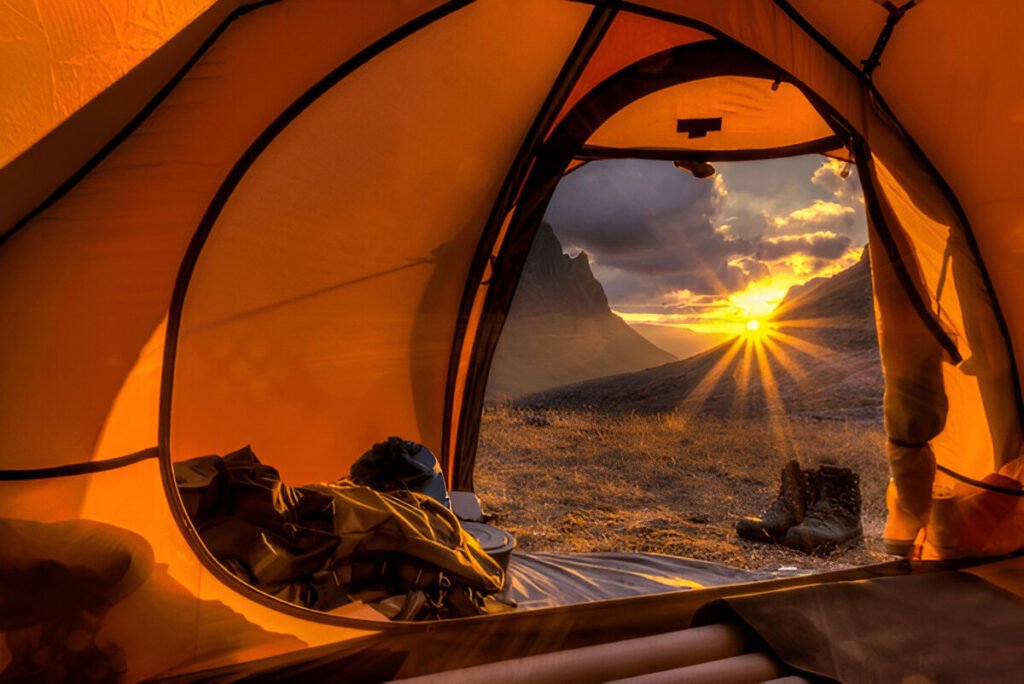Introduction
Wild camping is one of Scandinavia’s most cherished outdoor activities. Thanks to the region’s Allemansrätt or “Right to Roam,” campers can pitch their tents in stunning natural landscapes, from dense forests and serene lakes to rugged coastlines and majestic fjords.
This guide explores everything you need to know about wild camping in Scandinavia, including the rules, essential tips, and the most spectacular camping spots in Norway, Sweden, and Denmark.
Understanding the Right to Roam

The Right to Roam (Allemansrätt in Sweden and Allemannsretten in Norway) is a unique law that allows everyone to access nature freely. It ensures that individuals can hike, camp, and explore private and public lands with some limitations.
Key Guidelines:
- Respect Nature: Avoid damaging plants or disturbing wildlife.
- Leave No Trace: Carry out all your trash and leave the area as you found it.
- Stay for a Short Time: Typically, you can camp for up to two nights in one spot unless otherwise stated.
- Keep Your Distance: Stay at least 150 meters away from houses or cabins.
Benefits of Wild Camping in Scandinavia
- Unparalleled Scenery:
Wake up to stunning views of fjords, northern lights, or tranquil lakes.
- Serenity:
Escape the crowds and immerse yourself in nature’s peace and quiet.
- Affordable Travel:
With free camping spots, you can reduce accommodation costs significantly.
- Adventure:
Experience a true sense of freedom and adventure by exploring untouched landscapes.
Essential Tips for Wild Camping

- Plan Ahead:
Research the region, weather conditions, and camping regulations for your destination.
- Pack Smart:
- Tent: Lightweight, waterproof, and durable.
- Sleeping Bag: Choose one suitable for Scandinavian temperatures.
- Clothing: Layered, weather-appropriate clothes, including waterproof gear.
- Cooking Gear: A portable stove, lightweight cookware, and enough food supplies.
- Navigation Tools: Maps, a GPS device, or a reliable phone app.
- Weather Preparedness:
Scandinavia’s weather can change quickly. Always check forecasts and prepare for rain, wind, or sudden cold snaps.
- Safety Precautions:
- Inform someone about your plans.
- Carry a first aid kit.
- Be cautious around wildlife, particularly in remote areas.
- Respect Local Wildlife:
Avoid feeding animals and store food securely to prevent unwanted visitors.
Top Wild Camping Spots in Scandinavia

Norway
- Lofoten Islands
Known for its dramatic peaks and pristine beaches, Lofoten is a paradise for campers. Popular spots include Kvalvika Beach and Ryten Mountain.
- Jotunheimen National Park
Ideal for hikers and campers, this park features towering peaks, glacial lakes, and stunning valleys.
- Preikestolen (Pulpit Rock)
Camp near the trailhead and wake up early to hike to this iconic cliff for sunrise views over Lysefjord.
- Hardangervidda Plateau
This expansive plateau offers vast open spaces, perfect for wild camping amid alpine scenery.
Sweden
- Abisko National Park
Located in Lapland, this park is a favorite for Northern Lights watchers and hikers exploring the Kungsleden Trail.
- Skuleskogen National Park
Explore Sweden’s High Coast and camp in areas with breathtaking views of the Baltic Sea.
- Dalarna Region
Known for its rolling hills and dense forests, this region is perfect for a tranquil camping experience.
- Gotland
The island of Gotland offers a mix of beaches, cliffs, and historical sites, ideal for wild camping enthusiasts.
Denmark
- Mols Bjerge National Park
This area combines forests, hills, and coastal landscapes, making it a perfect spot for camping.
- Råbjerg Mile
Camp near Denmark’s famous migrating sand dune and enjoy the surrounding serene environment.
- Bornholm Island
Known as the “Sunshine Island,” Bornholm offers beautiful coastal areas and forests for wild camping.
- Thy National Park
Denmark’s first national park features sandy beaches, dunes, and heathlands, perfect for outdoor adventurers.
Wild Camping by Season

Spring (April–June):
- Mild weather and blooming landscapes.
- Fewer mosquitoes compared to summer.
Summer (July–August):
- Long daylight hours, including the Midnight Sun in northern Scandinavia.
- Warmer temperatures but more crowded and more insects.
Autumn (September–October):
- Cooler weather with vibrant fall colors.
- A quieter time with fewer tourists.
Winter (November–March):
- For adventurous campers seeking Northern Lights and snow-covered landscapes.
- Requires specialized gear for freezing temperatures.
Common Challenges and How to Overcome Them

- Insects:
Mosquitoes and midges can be a nuisance in summer. Use insect repellent and consider a bug net for your tent.
- Weather Extremes:
Scandinavian weather can be unpredictable. Always carry waterproof clothing and extra layers.
- Remote Locations:
Some areas have limited cell service. Carry a map and compass as a backup.
- Wildlife Encounters:
Avoid leaving food out and learn how to react to animals like moose or bears.
Wild Camping Etiquette
- Respect Fellow Campers: Maintain quietness and avoid intruding on others’ spots.
- Dispose of Waste Properly: Bury biodegradable waste and carry all trash with you.
- Follow Fire Regulations: Open fires are often restricted; use a portable stove instead.
Legal Considerations
- Protected Areas: Some national parks and nature reserves have specific restrictions. Check local regulations before camping.
- Private Land: While the Right to Roam applies, always ensure you’re not camping on cultivated fields or too close to private properties.
Conclusion
Wild camping in Scandinavia is an extraordinary way to connect with nature and experience the region’s unparalleled beauty. By following the Right to Roam principles, preparing adequately, and respecting the environment, you can embark on a memorable adventure under Scandinavia’s vast, open skies.
So grab your tent, embrace the spirit of adventure, and let Scandinavia’s natural wonders captivate you.











